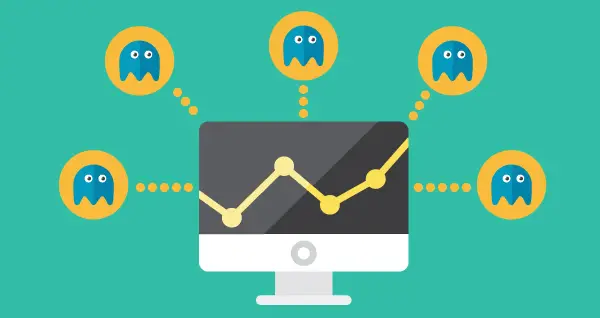Spammers suck, especially referral spam websites.
Persistent spammers suck worse and force us to stay on our toes when it comes to keeping our clients protected and their analytics accurate with data to help guide their marketing initiatives. However, the spammers are not going anywhere, and neither is our fight to keep them at bay while providing the best secure hosting as well as passionate search engine optimization.
During the last several weeks I have battled with varying types of spam, mostly from Russia, and have been amused by the lengths some of these spammers will go in order to garner traffic. I have been successful in our quest and wanted to share the information I have learned so that others can successfully remove spammers and ensure the data they are collecting is not skewed by spam traffic.
First, let’s look at the types of spam
Analytic Spam/Ghost Referrals
Analytic Referral Spam Websites, or “Ghost Referrals” as they have been dubbed, are those Russian referral sites you see in your analytics, but they never actually visit your site. They are simply spamming Google Analytic IDs at random in order to trick you into visiting their referral URL.
Crawler Spam
Crawler spam is essentially just websites that crawl around the internet gathering up information. They are still risky to visit due to their potential viruses depending on the site, so it’s still suggested to block them, which we will go over below.
Legit Bots
Most of the time these don’t show up in analytics, but occasionally you might see some. These are essentially the bots that are spidering your content to display in search engines. We’ll go over how to set your analytics to automatically filter these from view.
Search Spam
Search spam is essentially the same spammers using search terms to ping your analytics accounts in order to spam you. These users aren’t actually going to your website, and you can filter them from showing in your analytics, but it’s essentially another method of annoying you in order to garner traffic.
How can we combat spam websites?
Google Analytic Ghost Referrals and Crawler Spam Websites
People panic when they see Russian spam sites in their analytics. They think that these Russians are actually linking to their site providing negative backlinks that might affect their SEO.
Rest assured, most of these Russian spammers are not even remotely touching your website. Let’s look at some of the most well-known spam links:
- darodar.com
- pricereg.com
- econom.co
- buttons-for-website.com
- blackhatworth.com
- 7makemoneyonline.com
- semalt.semalt.com
- hulfingtonpost.com
- ilovevitality.com
- cenoval.ru
- bestwebsiteawards.com
The kicker is that most of these, such as darodar and ilovevitality.com, are not actually going to your website! These spammers are randomly going to google analytic user IDs in order to have their links show up in your analytic results, and in return hoping you will go to their website.
A user on reddit.com did an experiment by creating a brand new Google Analytics account for a fake website and fake company that did not exist. There was absolutely no site for these spammers to go to, but they were still showing up as spam referral accounts on the new analytics account.
Then there are crawlers that are actually crawling your site, such as semalt and buttons-for-website, which you may need to block through your .htaccess file.
What does this mean?
It means that you can block Russian referrals from your site (we’ll address this below), but it is not going to stop them from showing up in your analytics.
Well if they are not actually going to my site, then I shouldn’t need to worry, right?
Technically that is incorrect. There are two big reasons you’ll still want to remove this spam from showing in your results.
1. You want to have accurate data for marketing purposes. It is important to know how many actual potential customers are visiting your site, how they are getting there, what they do when they get to your site, and why they are leaving (your bounce rate). Having extra spam numbers in these results can skew them and make it more difficult to filter out the data you want, especially when it comes to your bounce rate.
2. Having a lot of bad “backlinks” in your analytic results could affect your search engine rankings if Google thinks you have “blackhat” backlinks linking to your website, despite the fact that it is a flaw in Googles Analytic system that is causing it.
The issue with staying on top of your spam referrals and search terms is that it IS a constant battle. New domains are always being purchased and new techniques are always being used. No small business owner has the time or patience to want to keep up with this, which is why companies like Misfit exist because we can take the burden off the small business owner so they can focus on running their business.
So if you find yourself drowning in a sea of Russian spam, let us know. We can help.
The Combat “Referral Spam Websites” TL;DR Checklist:
- Remove bots from showing in your analytics via the Bot Filtering tool by going to “View Settings” in your analytics account and ticking the “bot filtering” tool.
- Filter all Russian spam url’s from your Google Analytics by adding them to your referral exclusion list, and your view filters
- For referral spam websites go to your Admin panel in Google Analytics, then click on the “Filter” tool.
- Click on “New Filter” and type the name of this particular filter. I generally just put the domain name.
- Click “Custom” for filter type, and for this one we’ll select “Referral” from the excluded filter field.
- For “Filter Pattern” type in the exact url that you want to remove from your analytical data
- Repeat this exact process for the same domain, but for “Filter Field” click hostname instead. So you will essentially have at least two entries per domain.
- For search spam follow the same process, except under Custom, the “Filter Field” will be “Campaign Term”, and the pattern should be the legible wording verbatim. So for example “vitaly rules google”.
- Note: I have also had Russian lettering search spam that I’ve used the “Filter Field” for “Search Term” to successfully filter out from my analytical data.
- Lastly, if you suspect a site has malicious code on it, it never hurts to report it to google.




